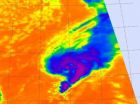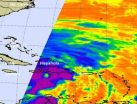(Press-News.org) Stroke survivors who smoke put themselves at a greater risk of additional strokes, heart attack or death than those who never smoked, according to new research in the American Heart Association's journal Stroke.
Those who quit smoking before their stroke also had less risk of poorer outcomes than current smokers, researchers found.
Researchers in Melbourne, Australia, tracked 1,589 patients who experienced a first or recurrent stroke in 1996-99. They followed them for 10 years, using medical records and in-person and telephone interviews, and tracked demographics, deaths, recurrent strokes and heart attacks.
Compared to those who never smoked:
Those who smoked when they had a stroke were 30 percent more likely to have a poor outcome.
Among those who survived the first 28 days after stroke, current smokers had a 42 percent higher risk of poorer outcomes.
Ex-smokers had an 18 percent higher risk of poorer outcomes.
Compared to past smokers:
Among those who survived the first 28 days after stroke, current smokers had a 23 percent higher risk of poorer outcomes during the 10 years.
"This research provides fresh incentive to quit smoking now or never start because it shows smokers fare far worse after strokes than non-smokers," said Amanda Thrift, Ph.D., the study's lead researcher and professor of epidemiology for the Department of Medicine in the Southern Clinical School at Monash University in Clayton, Victoria, Australia.
In the study, those living in disadvantaged areas were much more likely to smoke, with 52 percent of current smokers belonging to the most disadvantaged group, compared to 31 percent of those who never smoked.
"We also found smoking had its greatest impact on younger patients," Thrift said. "The people who smoked in our study were younger, more often male, and more often from a disadvantaged background. Although we want everyone to give up smoking, targeting this group could yield greater benefits with fewer dollars spent."
The study focused on patients who survived the most common type of stroke: an ischemic stroke (caused by blood clot). Researchers didn't link smoking to poorer long-term outcomes for patients whose stroke was caused by bleeding within the brain (intracerebral hemorrhage), possibly due to a small sample size.
Previous studies, which have been shorter, had a smaller sample size or were less comprehensive, have provided inconsistent results on smoking's role on long-term outcomes after a stroke.
Stroke is the fourth-leading cause of death and the leading cause of adult disability in the United States.
Someone in America has a stroke about every 40 seconds.
###Co-authors are Joosup Kim, BBiomedSci; Seana Gall, Ph.D.; Helen Dewey, Ph.D.; Richard Macdonell, M.D.; and Jonathan Sturm, Ph.D. Author disclosures are on the manuscript.
The National Health and Medical Research Council, Victorian Health Promotion Foundation, Foundation for High Blood Pressure Research and the National Stroke Foundation funded the study.
Learn more about stroke.
Follow @HeartNews on Twitter for the latest heart and stroke news.
For stroke science, follow the Stroke journal at @StrokeAHA_ASA.
Statements and conclusions of study authors published in American Heart Association scientific journals are solely those of the study authors and do not necessarily reflect the association's policy or position. The association makes no representation or guarantee as to their accuracy or reliability. The association receives funding primarily from individuals; foundations and corporations (including pharmaceutical, device manufacturers and other companies) also make donations and fund specific association programs and events. The association has strict policies to prevent these relationships from influencing the science content. Revenues from pharmaceutical and device corporations are available at www.heart.org/corporatefunding.
Stroke survivors who smoke raise risk of more strokes, heart attack, death
2012-10-26
ELSE PRESS RELEASES FROM THIS DATE:
C'est difficile
2012-10-26
In a new study out today, researchers used mice to identify a combination six naturally occurring bacteria that eradicate a highly contagious form of Clostridium difficile, an infectious bacterium associated with many hospital deaths. Three of the six bacteria have not been described before. This work may have significant implications for future control and treatment approaches.
The researchers found that this strain of C. difficile, known as O27, establishes a persistent, prolonged contagious period, known as supershedding that is very difficult to treat with antibiotics. ...
Researchers at the doorstep of stem cell therapies for MS, other myelin disorders
2012-10-26
When the era of regenerative medicine dawned more than three decades ago, the potential to replenish populations of cells destroyed by disease was seen by many as the next medical revolution. However, what followed turned out not to be a sprint to the clinic, but rather a long tedious slog carried out in labs across the globe required to master the complexity of stem cells and then pair their capabilities and attributes with specific diseases.
In a review article appearing today in the journal Science, University of Rochester Medical Center scientists Steve Goldman, ...
Traditional fisheries management approach jeopardizes marine ecosystems worldwide
2012-10-26
STONY BROOK, NY– In a Perspectives article, "The Risks of Overfishing," published today in the journal Science, Dr. Ellen K. Pikitch, executive director of the Institute for Ocean Conservation Science and professor at Stony Brook University, cautions against continuing traditional fisheries management. According to Dr. Pikitch, current and recent studies demonstrate the need for "a more precautionary approach to fisheries management, in which fishing is restricted to those places and amounts where it can be conducted safely and with minimal risk of jeopardizing the integrity ...
'Adoption activity days' can help children find new families
2012-10-26
Children's parties or activity days, where prospective adopters meet children awaiting adoption, could be part of the solution to the current adoption crisis, according to research that will be showcased during the Economic and Social Research Council (ESRC) Festival of Social Science.
"Such parties or activity days went out of fashion in the 1980s but no one is sure why," says Katherine Runswick-Cole of Manchester Metropolitan University who led the research. "However, our pilot study has shown an overwhelmingly positive response from practitioners, adopters and the ...
A black widow's Tango Mortale in gamma-ray light
2012-10-26
This press release is available in German.
Pulsars are the compact remnants from explosions of massive stars. Some of them spin around their own axis hundreds of times per second, emitting beams of radiation into space. Until now, they could only be found through their pulsed radio emissions. Now, scientists at the Max Planck Institute for Gravitational Physics (Albert Einstein Institute/AEI) in Hanover assisted by the Max Planck Institute for Radio Astronomy have discovered a millisecond pulsar solely via its pulsed gamma radiation. A new data analysis method developed ...
Smoking takes 10 years off life expectancy in Japan, not 4 as previously thought, experts warn
2012-10-26
Smoking reduces life expectancy by ten years in Japan, but much of the risk can be avoided by giving up smoking, a paper published on bmj.com today shows.
Previous studies in Japan suggested smoking reduced life expectancy by only a few years compared with about ten years in Britain and the USA. This new report, from researchers in Oxford and Japan, investigates the impact of smoking on mortality in a large group of Japanese people who were living in Hiroshima or Nagasaki in 1950. The findings are, however, nothing to do with radiation exposure from the bombs.
The ...
US investment in biomedical and health research on downward trend
2012-10-26
WASHINGTON, DC—October 25, 2012—Biomedical and health research and development (R&D) spending from all sources declined by more than $4 billion or 3% between FY10 and FY11 according to Research!America's 2011 U.S. Investment in Health Research report. This represents the first drop in overall spending since Research!America began compiling the data in 2002.
The decline follows an uptick in research funding attributed to the American Recovery and Reinvestment Act (ARRA), which allocated $10.4 billion to the National Institutes of Health (NIH) over two fiscal years (2009-2010). ...
NASA sees warming cloud tops indicating Tropical Storm Tony weakening
2012-10-26
In a tropical cyclone, strong uplift of air pushes the tops of thunderstorms high into the troposphere. When that strength wanes, the cloud tops drop and become less cold. That's because the higher you go in the troposphere, the colder it gets. NASA satellite infrared data has revealed that Tropical Storm Tony's cloud top temperatures are warming and the storm is weakening.
The Atmospheric Infrared Sounder (AIRS) instrument aboard NASA's Aqua satellite captured infrared imagery of Tropical Storm Tony on Oct. 24 at 12:17 p.m. EDT that showed the strongest thunderstorms ...
NASA sees power in Hurricane Sandy moving toward Bahamas
2012-10-26
NASA's Aqua satellite passed over Hurricane Sandy as it was moving over eastern Cuba early on Oct. 25. The AIRS instrument captured an infrared image of Sandy that showed a large area of very high, cold cloud tops indicating the power within the storm. Sandy is now headed toward the Bahamas and warnings and watches have already been posted for the mainland U.S.
The Atmospheric Infrared Sounder (AIRS) instrument aboard NASA's Aqua satellite captured infrared imagery of Hurricane Sandy's eastern half on Oct. 25 at 0559 UTC (1:59 a.m. EDT) that showed some strong thunderstorms ...
NASA saw Tropical Storm Murjan making landfall on the Horn of Africa
2012-10-26
NASA's Aqua satellite watched from space as Somalia in the Horn of Africa experienced a landfalling tropical cyclone on Oct. 25.
On Oct. 25, NASA's Aqua satellite saw Tropical Storm Murjan begin to make landfall in eastern Somalia, just south of Cape Guardafui. Cape Guardafui is located in the northeastern Bari province and forms the geographical point of the Horn of Africa.
On Oct. 25, 2012 at 0720 UTC (3:20 a.m. EDT) the Moderate Resolution Imaging Spectroradiometer (MODIS) instrument that flies aboard NASA's Aqua satellite captured a visible image of Tropical Storm ...




